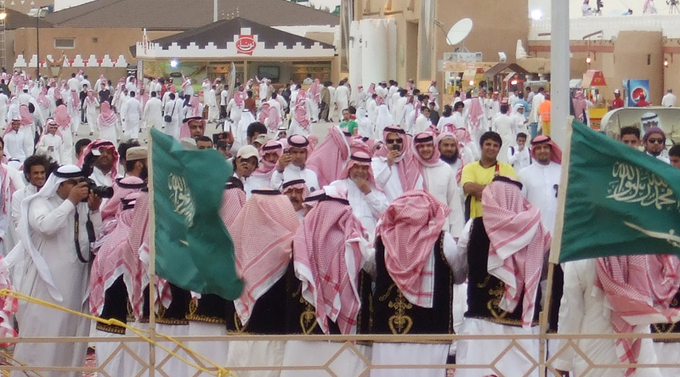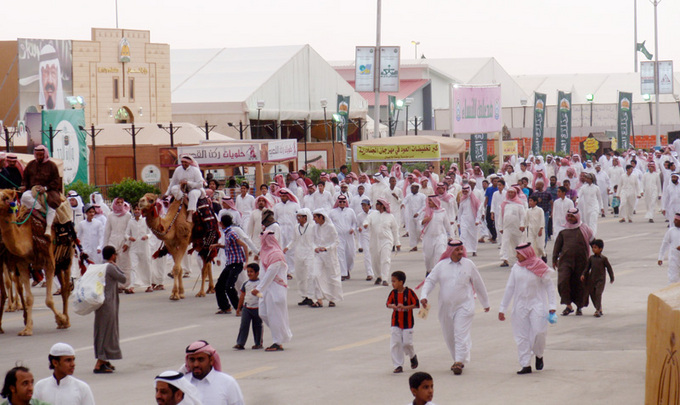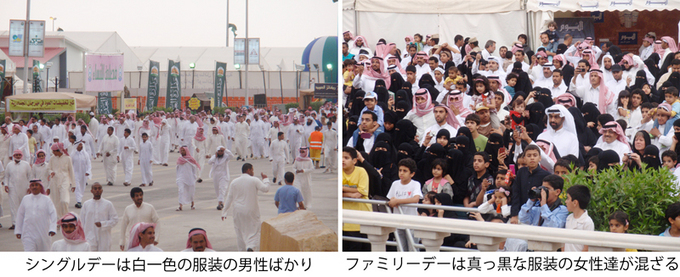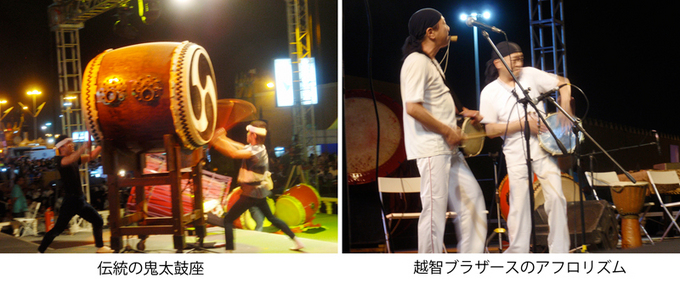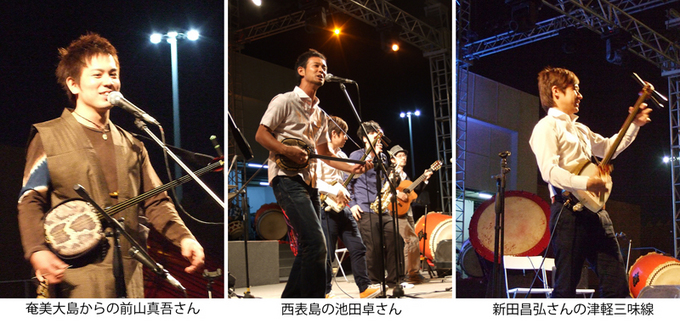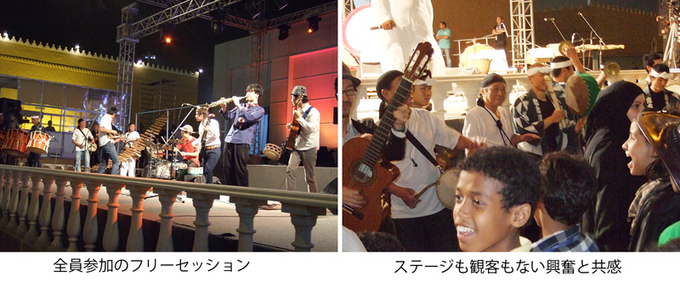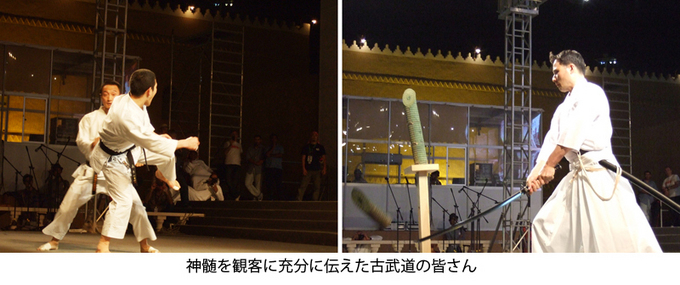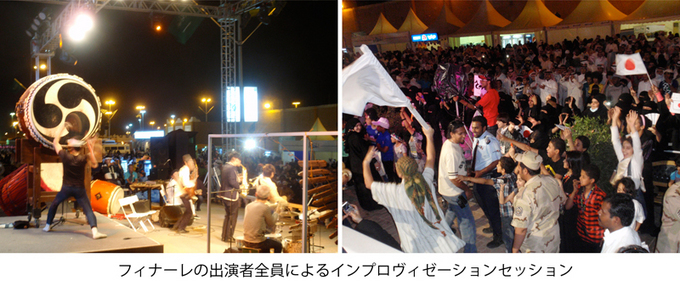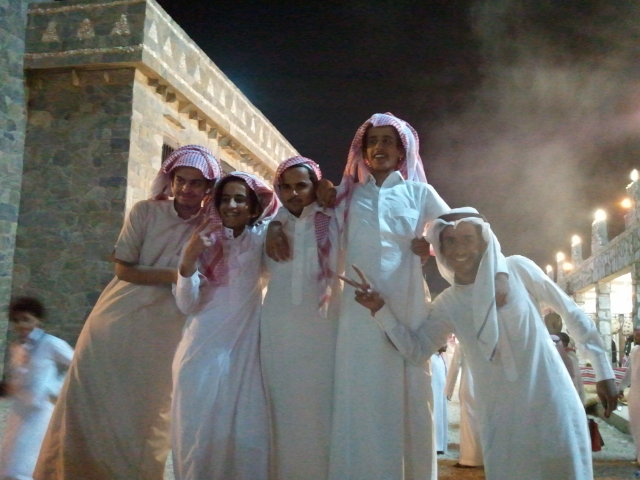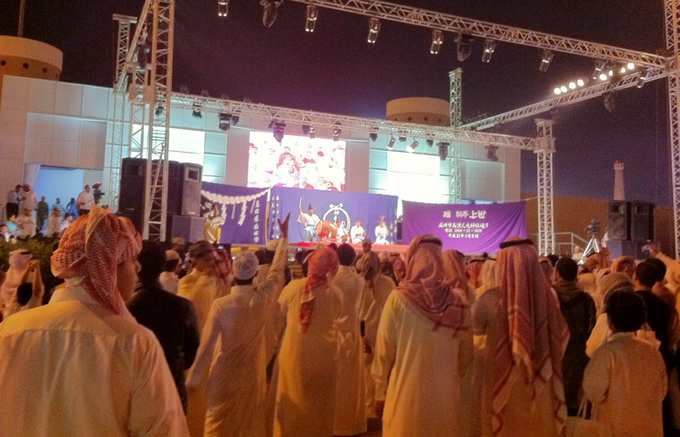Saudi Arabia: Shimauta Resonating Across the Desert
Mitsuo Tamura, President, STATION Co., Ltd.
The sun and our fellow workers
Nothing was there but a concrete platform jutting out from a building. No truss or steel structure used to build a stage, no lighting or sound equipment. This was literally in the middle of a desert. What's more, it looked like they hadn't even started the construction work at most of the other pavilions. I couldn't help but wonder, "Is the festival touted as Saudi Arabia's largest event really going to take place here, in just a few days?" The Japanese staff members who had arrived earlier clearly appeared tired, just resting in the shade, and I could tell they were suffering from mental fatigue, not physical. When working on an international project like this, the first thing our team needs do is to pick up our counterpart's work practices and find ways for us to work together. On this particular project we had sent a select group of production team members with plenty of overseas experience, and yet here they were, a week into preparation and nothing much to show for it. This was beyond anything I had imagined.
It is three o'clock in the afternoon and not a single person is working. Everyone is taking refuge from the blazing sun and lying down or squatting in the shade. And nobody will move until the sun is low in the sky. It's the movement of the sun that dictates their work hours, which are generally a few hours in the late afternoon. Forget the firm promises they made the previous day to show up and start work at a certain hour; these workers follow the movement of the earth and the weather of the day, not the time displayed on a clock.
Any cross-cultural experience invariably begins like this, with everyone trying to get used to each other's cultures. At times the biggest challenge in a foreign culture can be nature itself. People around the world have established their ways of life based on the overpowering natural environment. To understand a new culture you must first understand the nature that surrounds it and the people who live in harmony with it. Our initial job, then, is to accept nature as it is before us.
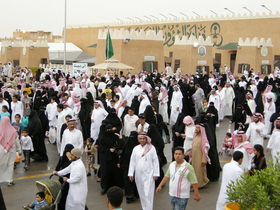 It was around the time when I had finally grown accustomed to the local ways that the theatrical equipment and the vehicles that carry them arrived at the site. The drivers of the vehicles were mostly migrant workers from abroad--Jordanians, Syrians and Lebanese. They were either individual workers hired by local companies or workers of small production teams. The equipment that arrived was then passed onto laborers from countries like Pakistan and Bangladesh, who carried the heavy loads by hand. They seemed reluctant to talk to us. Saudi Arabia is also home to the Bedouins, but they are not granted full citizenship and therefore not permitted to work. Banned from this area, they live quietly in other parts of the desert. These men of different backgrounds and cultures are our fellow workers with whom we would be working together everyday for the next month. (In fact, there are other fellow workers I have yet to introduce.) We quickly hit it off. The Japanese staffers have made friends with the project's key figures on the local team, and while little work has been accomplished, the workers are getting along quite well, chatting about their families, food and what not. It's not clear to me what language they are communicating in, but I know this is the frontline of an intercultural exchange.
It was around the time when I had finally grown accustomed to the local ways that the theatrical equipment and the vehicles that carry them arrived at the site. The drivers of the vehicles were mostly migrant workers from abroad--Jordanians, Syrians and Lebanese. They were either individual workers hired by local companies or workers of small production teams. The equipment that arrived was then passed onto laborers from countries like Pakistan and Bangladesh, who carried the heavy loads by hand. They seemed reluctant to talk to us. Saudi Arabia is also home to the Bedouins, but they are not granted full citizenship and therefore not permitted to work. Banned from this area, they live quietly in other parts of the desert. These men of different backgrounds and cultures are our fellow workers with whom we would be working together everyday for the next month. (In fact, there are other fellow workers I have yet to introduce.) We quickly hit it off. The Japanese staffers have made friends with the project's key figures on the local team, and while little work has been accomplished, the workers are getting along quite well, chatting about their families, food and what not. It's not clear to me what language they are communicating in, but I know this is the frontline of an intercultural exchange.
Arab Spring and the Great Earthquake in Japan
The Janadriyah National Festival for Heritage and Culture is Saudi Arabia's largest cultural extravaganza held annually, featuring, among other activities and attractions, cultural exhibits, traditional dance, music, and arts from various regions throughout the country. The festival, hosted by the Saudi King, asks one foreign country each year to set up a pavilion, and present exhibits and performances introducing its culture, which mark the highlight of intercultural experience. Japan was selected as the country of honor in 2011, and extensive preparations had been under way for the event scheduled to take place in late February through early March. The Japanese Embassy in Riyadh had organized a festival planning committee, and the participating companies, government agencies and groups were each making plans in line with the core themes like "the diversity of culture, prosperity, and cutting edge technology." The Japan Foundation was putting together an exhibition titled "Authentic Japan: Japanese Origin, Nature, History and Traditional Culture," that included displays of historical items such as samurai armor and helmet, swords, and folding screens. The demonstrations of traditional flower arrangement, painting and tea ceremony were also being coordinated. In addition, Japan was going to set up a full-scale outdoor stage adjacent to the pavilion for daily performances showcasing its arts and culture. All told, an unparalleled grand-scale project had been in the making.
Right before its opening, however, we learned that the festival was going to be postponed due to the King's illness. Some time later the organizers told us it was going to take place in April, but by then the revolution that had started in Tunisia caused the wave of protests to spread to neighboring countries like Egypt and Libya, dramatically transforming the political and social landscape across the region. Although the Japanese news reports hardly mentioned Saudi Arabia in relation to the ongoing upheavals, those of us involved in the festival couldn't help being concerned about the situation there.
Then came an event that no one anticipated: the Tohoku disaster on March 11, 2011. It was an unprecedented disaster of a massive earthquake, tsunami and subsequent nuclear power plant crisis. I am sure each of the staff members and artists were affected by the tragedy, directly or indirectly, and grieving in their own way. I would imagine the organizers gave careful consideration whether or not to press ahead with the project .
Japan would take part in the Janadriyah Festival, which was to start on April 13, as previously planned. Once this was decided, the targets became clear. Schedules were set and arrangements were made. Fortunately, most of the artists and performers agreed to the revised dates, allowing us for the most part to go forward with the original programs. While loud music or flashy shows were avoided in Japan at the time, every participating musician, artist and staff member shared the same recognition that music, dance and the festival are in themselves an expression of our appreciation of nature and an act of remembering the deceased; that the basis of music and the spirit of prayer stem from a mother's lullaby soothing her child in a temporary shelter or a bomb shelter.
Approaching darkness
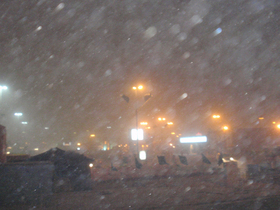 On the day before the opening of the festival, the area around the pavilions suddenly starts to dim as if enveloped by darkness and the far-away scenery gradually disappears as if veiled by mist. You feel pain in your eyes, followed by your throat, and then the pain sinks deep down into your chest. That's what happens with the sandstorms of this region, which strike every three days or so. I have encountered raging sandstorms accompanied by strong winds elsewhere, but this is a different kind altogether--it approaches with no sound. You look up and suddenly the area around you is surrounded by darkness. These blurry clouds of sand that engulf you like mist are a little like radioactivity; you don't see them coming and accumulating. You cannot fight it; no lies, excuses or delaying tactics will work. You have no choice but to watch the sand falling and to learn how the local people cope. In other words, plan or no plan, when a sandstorm hits, everything stops.
On the day before the opening of the festival, the area around the pavilions suddenly starts to dim as if enveloped by darkness and the far-away scenery gradually disappears as if veiled by mist. You feel pain in your eyes, followed by your throat, and then the pain sinks deep down into your chest. That's what happens with the sandstorms of this region, which strike every three days or so. I have encountered raging sandstorms accompanied by strong winds elsewhere, but this is a different kind altogether--it approaches with no sound. You look up and suddenly the area around you is surrounded by darkness. These blurry clouds of sand that engulf you like mist are a little like radioactivity; you don't see them coming and accumulating. You cannot fight it; no lies, excuses or delaying tactics will work. You have no choice but to watch the sand falling and to learn how the local people cope. In other words, plan or no plan, when a sandstorm hits, everything stops.
Shimauta resonating across the desert
Would the Saudis enjoy Japan's performance programs like Iwami Kagura (Masuda district and Hamada district preservation societies), the traditional Shinto music and dance?
Finally, it's April 14 and the first day of the festival. Huge crowds of festive spectators pass by our stage, and they are all dressed in white robes with scarves of red and white on their heads--a typical outfit of Saudi men. In the beginning the sight of these men all dressed the same struck me as bizarre. Seeing it on television and seeing it in person is not quite the same, because wherever you look, you see men in white, all day long. And it's only men you see for the first several "singles day" when women aren't allowed to come. For four whole days we were surrounded by a crowd of white robes. The fifth day onward is "family day" and women covered in black from head to toe join the event. The spectators are paying close attention to our every move. With their faces masked in black, the women turn their piercing gaze towards us, the foreign visitors. It's hard to tell if we are being welcomed, and we cannot help feeling like total outsiders as we wait for the performance to start.
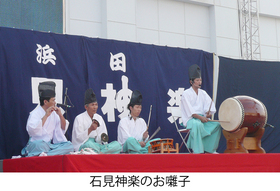 Anyhow, it's show time. The music of Iwami Kagura begins and the sacred song echoes throughout the pavilion. To my great surprise, the audience in front of the stage begins to sing to the melody in low, deep voices as if to respond to the sacred song. Every time they hear a script or a lyric, the crowd chants out loud in response. Soon we have the call and response interaction between the performers and the crowd, the kind you would see in a funk music concert. I knew that some of the music performed in Islamic ceremonies sounds sort of like enka (Japanse ballads), sang with a pulsating effect in a vocal tone, but it never occurred to me that their religious music and kagura would blend together so well. Nowhere else in the world have I seen the whole crowd immediately start singing to the tune of kagura.
Anyhow, it's show time. The music of Iwami Kagura begins and the sacred song echoes throughout the pavilion. To my great surprise, the audience in front of the stage begins to sing to the melody in low, deep voices as if to respond to the sacred song. Every time they hear a script or a lyric, the crowd chants out loud in response. Soon we have the call and response interaction between the performers and the crowd, the kind you would see in a funk music concert. I knew that some of the music performed in Islamic ceremonies sounds sort of like enka (Japanse ballads), sang with a pulsating effect in a vocal tone, but it never occurred to me that their religious music and kagura would blend together so well. Nowhere else in the world have I seen the whole crowd immediately start singing to the tune of kagura.
The following sessions of Music & Rhythms go beyond the original purpose of introducing contemporary Japanese music as world music, and develop into something of a global experience. It starts with the traditional Ondekoza taiko performance, and loud applause and cheers go up with each strike of taiko (Japanese drums). Enter the African drumbeats of Ochi Brothers, the percussion duo, and you have crowds in the front rows dancing rhythmically. Nobody seems to care that the Japanese taiko and African drums are somewhat off-beat with each other.
Next, a couple of artists from the southwestern islands of Japan take to the stage. Shingo Maeyama's shimauta (folk songs of Okinawa), so full of life and vitality, seems to captivate the souls of the audience and they sing along in unison, creating a resounding chorus. Suguru Ikeda's shimauta carries a strong message coming all the way from a remote Okinawan island, and the singer takes a passionate pause before his voice turns into a tune. The moment he starts singing, the audience joins in. They are connecting. After that, the sound of the sanshin (Okinawan string instrument) creates a swaying, alternating rhythm; sometimes it's blues, other times oiwake (Japanese folk music). Living their lives surrounded by a vast ocean of sand, it may have come naturally for the Saudis to relate to the island song emerging from across a remote sea. The session continues.
Next up is Masahiro Nitta, who plays the Tsugaru shamisen (string instrument of Tsugaru region). After performing oiwake he slips into a faster, more upbeat tempo, building momentum and getting the crowd into the groove. Amid the excitement of a rock concert, the Kazutoki Umezu Trio enters and everybody on stage is doing their own thing. As the show reaches its climax, the Ondekoza troupe makes its way onto the stage with their taiko and the crowd goes wild, thumping their feet and cheering loudly. Eastern music, Western culture--all of that no longer matters, and the scene represents a global celebration taking place in a small village somewhere, anywhere, on the earth. Together, we are all giving life to this festival that could only be made here, at this place, with these people. Dancing, singing and cheering, everyone, the performers and the spectators alike, are sharing the great excitement and joy.
A global festival
Music & Rhythms is a new musical project launched in 2005 that is organized around five themes: nature, music, children, community and earth. It initiates unique, spontaneous musical festivals worldwide that typically begin with a children's workshop to create musical instruments. Then those children, joined by professional musicians of any music genre, including local musicians, create original music based on the local experience. Recent performances include Music & Rhythms TOKYO KIDS in Japan and other events involving local musicians and children in various places such as countries in Africa. It was difficult in Saudi Arabia to arrange a workshop with the local children, whom we were able to interact with only at the festival site. Nevertheless, those children we did meet left us with a precious experience each time.
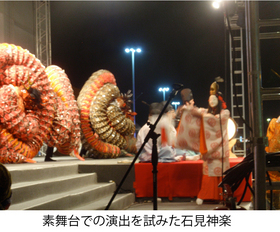 Granted, while it is essential for the artists and performers to make the most of what they have, it is equally important for them to be driven by a desire to collaborate with the local people and to discover something new during the two-week experience. So we had this rule that the shows did not have to be identical everyday, and we encouraged the performers to try new things, to be spontaneous. For example, Iwami Kagura was performed on the final day on an open stage, without any curtains. It also meant a lot to me to meet young Japanese performers who were not simply trying to maintain the traditions of kagura, an art now on the verge of dying out, but who were exploring new directions for it. The dancers don't dance merely to preserve the tradition. It's meaningless to do something just for the sake of doing it. It's when the dancers embrace the pleasure and the empathy that true kagura comes to life, and the unchanging delight remains as tradition. I am certain that what the performers learned through their experience at the Janadriyah Festival will stay with them and help them in their efforts to reinforce and support new traditions in the future.
Granted, while it is essential for the artists and performers to make the most of what they have, it is equally important for them to be driven by a desire to collaborate with the local people and to discover something new during the two-week experience. So we had this rule that the shows did not have to be identical everyday, and we encouraged the performers to try new things, to be spontaneous. For example, Iwami Kagura was performed on the final day on an open stage, without any curtains. It also meant a lot to me to meet young Japanese performers who were not simply trying to maintain the traditions of kagura, an art now on the verge of dying out, but who were exploring new directions for it. The dancers don't dance merely to preserve the tradition. It's meaningless to do something just for the sake of doing it. It's when the dancers embrace the pleasure and the empathy that true kagura comes to life, and the unchanging delight remains as tradition. I am certain that what the performers learned through their experience at the Janadriyah Festival will stay with them and help them in their efforts to reinforce and support new traditions in the future.
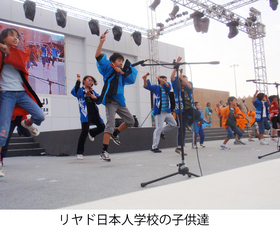 Just when the shows were starting to become a little monotonous after several days, children from the Riyadh Japanese School joined the stage, bringing a welcome respite to the performers and the staff. It is also worth mentioning that the demonstration by the karate and kobudo (old martial arts) performers, who were gracious enough to attend despite their busy schedule, was very successful. There was a blackout and the demonstration was barely visible in the darkness, but I can proudly report that they succeeded in conveying the essence of martial arts through the sounds of breathing, feet shuffling across the floor, and the fighting spirit.
Just when the shows were starting to become a little monotonous after several days, children from the Riyadh Japanese School joined the stage, bringing a welcome respite to the performers and the staff. It is also worth mentioning that the demonstration by the karate and kobudo (old martial arts) performers, who were gracious enough to attend despite their busy schedule, was very successful. There was a blackout and the demonstration was barely visible in the darkness, but I can proudly report that they succeeded in conveying the essence of martial arts through the sounds of breathing, feet shuffling across the floor, and the fighting spirit.
At the show's grand finale, all musicians and artists, including Ondekoza and Ochi Brothers, gave an improvisational performance. Kiyomitsu Maeda, the synthesizer player and a Riyadh resident who performed at our team's opening gala, also joined this closing session. The unique "festival of the Earth" lasted late into the night. Incidentally, a group of female fans in front of the stage seemed mostly drawn to Hiroshi Suzuki, the saxophone player, and apparently he was pursued with requests for autographs and photos.
Music: appreciation of nature and prayer to the soul
Now, let's get to the bottom of what the enthusiastic response that greeted us at the opening of the show was all about. It was unexpected considering the Japanese team was feeling like outsiders just moments earlier.
In Saudi Arabia, music is not a part of people's daily lives. There is hardly any opportunity for the Saudis to listen to music at a concert. Buying tickets for seats at a show is not a common experience for them. In other words, music is not seen as a commercial product in Saudi society. The powerful energy of music, nevertheless, is firmly rooted in their religious ceremonies and prayers. That's why the people see music as something to sing along to, dance with, and enjoy with everybody else. It's not in their culture to sit quietly and appreciate a musician's technical skills, or to pay money to be entertained at a concert. The prayers and preaching in the Koran clearly define the meaning of music for them.
All this is in stark contrast with Japanese society, where music from all over the world can be heard non-stop in various public places and where a concert is treated as a product of entertainment. But when you think about the original purpose of music and what music is really about, I think there is a worthwhile question to consider. Isn't music a manifestation of heartfelt emotions, an appreciation of nature and prayer to the soul? Music should have meaning and reason. If music should really be a message, a prayer and something unique to a particular occasion, then we had the opportunity at this festival to reclaim music as exactly those things. That was evident when shimauta, a song coming from a distant sea, created a strong feeling of empathy among the people living in a sea of desert sand. The pain and sorrow that each Japanese participant carried in their heart must have had a deep connection with the prayers of the Saudi people.
The Earth--Saudi Arabia and Japan
There is another memorable thing I'd like to mention. At the festival, the scenes of excited crowds were shown live on a TV screen. Everyone was dancing merrily, men and women, moving their hips and arms. This image, unacceptable in their religion, caused serious trouble. It was equivalent to committing the crime of dishonoring the Emperor in pre-war Japan. First, the religious police that kept daily watch ordered us to change the camera work. We were agonizing over what to do when the Saudi National Guard, the organizer of the event, urged us to carry on. Later, we were instructed to suspend all shows. In the end, the religious police and the National Guard held talks and decided that the shows could go on.
In addition to these two law enforcement bodies, Saudi Arabia also has the Royal Security Force, a special unit protecting the royal family which to me seemed the most formidable. Apart from the military, the religious police, the National Guard and the Royal Security Force comprise the state power centering on the royal family. Local police exist but appeared to command less authority. The National Guard prevented them from entering certain areas, even when we had our musical instruments stolen. As I mentioned before, the people with whom we had frequent contact were not Saudis but mostly overseas workers. The Saudis belong in the upper echelon of the power structure, and society has long relied on this system where a handful of tribes with connections to the royal family redistribute wealth acquired through oil.
In my view, Arab authoritarian regimes have managed to continue to this day without any significant structural changes since Western colonial powers forced statehood and national boundaries onto the tribal or band societies of this region that were historically defined primarily by the natural environment. This is also what I observed in several of the African countries I have visited. And when I look back at Japan, I see the entrenched networks of government, bureaucracy and industry--designed to maintain postwar prosperity and the status quo--continuing to thrive today in the same manner across various sectors and areas of society, such as nuclear power plants, US military bases, and dams. Over the years the Japanese have never made any serious attempts to remove this structure. All the while, the earth keeps turning without notice, equally bestowing the blessings and curses of nature across the globe. When a sandstorm hits, you watch the sand accumulate quietly like radioactive materials, and you realize you are facing a situation over which you have no control. There is but one earth, and there is but one challenge--it presents itself in different forms in different parts of the world, questioning the way each of us live our lives.
During the festival we would return to our hotel rooms at one or two o'clock in the morning each day. Despite the late hour, the staff got together and discussed the events of the day over a drink or two. That's what we do wherever we go, only there is no "drink" in Saudi Arabia, where alcohol is prohibited for religious reasons. So we turned to non-alcoholic beer, and there was a good variety of them to choose from. We would go looking for different flavors day to day--the straight barley type today, the lemon and flavor the next day, and so forth--at a local convenience store late at night. The funny thing was the non-alcoholic beer would soon get us tipsy. We would bandy about what went on during the day, have a few bottles, and then return to our own rooms feeling drunk. It helped us sleep well, this non-alcoholic drink habit, although as soon as we returned to Japan we quickly went back to our old ways.
* Janadriyah Festival
One of the largest festivals in the Middle East; its official name is Saudi Arabia National Heritage and Folk Culture Festival (Al-Maharajan al-watani lil-turath wa al-thaqafa al-Janadriya). The festival, which celebrated its 26th anniversary in 2011, attracts over one million visitors each year and is attended by the members of Saudi royal family and foreign dignitaries. Every year a different country is invited to the festival as the guest of honor and is asked to introduce its history and culture. Japan was invited in 2011, following Turkey, Russia, and France in the preceding years.
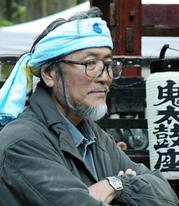 Mitsuo Tamura
Mitsuo Tamura
President of STATION, Co. Ltd., Director of Music & Rhythms TOKYO KIDS, Director of NPO Bamboo Orchestra Japan, Secretary General of Pacific Basin Performing Arts Communication Japan (PARC)
Tamura has been involved in launching various community events such as Artcamp Hakushu, Echigo-Tsumari Art Triennial, and Setouchi International Art Festival. He has also helped organize Europalia 89 Japan and WOMAD Yokohama, and was involved in the planning, coordination and production of numerous international programs, shows and events, including NGO Global Village and Earth Collaboration at the World Exposition in Aichi (EXPO 2005), Japan-Brazil Immigration 100th Anniversary Concert, the citizen's initiative pavilion El Faro at the International Exposition in Zaragoza, Spain (EXPO 2008), EU 50th Anniversary Tour, the musical The Palm-Wine Drinkard commemorating the Tokyo International Conference on African Development (TICAD). Tamura received wide acclaim for the spectacular re-enactment of Genghis Khan's Cavalry Ride featuring 500 cavalry men and horses at Mongolia's 800th Anniversary Festival in 2006 that he produced.
His cherished themes are travels, festivals, and dreams of the Earth.
Related Events
Keywords
- Ethnicity
- Traditional Arts
- Performing Arts
- Music
- Philosophy/Religion
- International Exhibition
- Cultural Diversity
- Cultural Policy/Public Diplomacy
- Saudi Arabia
- Janadriyah Festival
- international exchange
- Bedouin
- culre
- festival
- Tunisia
- Egypt
- Libya
- Great East Japan Earthquake
- Iwami Kagura
- world music
- Music & Rhythms
- Ondekoza
- Ochi Brothers
- Shingo Maeyama
- Taku Ikeda
- Masahiro Nitta
- Kazutoki Umezu Trio
- Africa
Back Issues
- 2025.6. 9 Creating a World Tog…
- 2024.10.25 My Life in Japan, Li…
- 2024.5.24 The 50th Japan Found…
- 2024.5.24 The 50th Japan Found…
- 2024.5. 2 People-to-People Exc…
- 2024.5. 2 People-to-People Exc…
- 2023.12. 7 Movie Theaters aroun…
- 2023.6.16 The 49th Japan Found…
- 2023.4.24 The 49th Japan Found…
- 2022.12.27 Living Together with…


